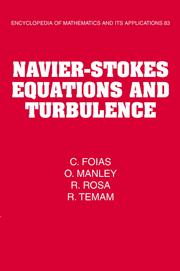Book contents
- Frontmatter
- Contents
- Preface
- Acknowledgments
- Chapter I Introduction and Overview of Turbulence
- Chapter II Elements of the Mathematical Theory of the Navier–Stokes Equations
- Chapter III Finite Dimensionality of Flows
- Chapter IV Stationary Statistical Solutions of the Navier–Stokes Equations, Time Averages, and Attractors
- Chapter V Time-Dependent Statistical Solutions of the Navier–Stokes Equations and Fully Developed Turbulence
- References
- Index
Chapter IV - Stationary Statistical Solutions of the Navier–Stokes Equations, Time Averages, and Attractors
Published online by Cambridge University Press: 14 August 2009
- Frontmatter
- Contents
- Preface
- Acknowledgments
- Chapter I Introduction and Overview of Turbulence
- Chapter II Elements of the Mathematical Theory of the Navier–Stokes Equations
- Chapter III Finite Dimensionality of Flows
- Chapter IV Stationary Statistical Solutions of the Navier–Stokes Equations, Time Averages, and Attractors
- Chapter V Time-Dependent Statistical Solutions of the Navier–Stokes Equations and Fully Developed Turbulence
- References
- Index
Summary
Introduction
As mentioned earlier in this text, we take for granted that the Navier–Stokes equations (NSE), together with the associated boundary and initial conditions, embody all the macroscopic physics of fluid flows. In particular, the evolution of any measured property of a turbulent flow must be relatable to the solutions of those equations. In turbulent flow regimes, the physical properties are universally recognized as randomly varying and characterized by some suitable probability distribution functions. In this and the following chapter, we discuss how those probability distribution functions (also called probability distributions or measures, or Borel measures, in the mathematical terminology; see Appendix A.1) are determined by the underlying Navier–Stokes equations. Although in many cases such distributions may not be known explicitly, their existence and many useful properties may be readily established. For many practical purposes, such partial knowledge may be all that is needed. Thus we note that the issue of an explicit form of the distribution function – in particular, whether this measure is unique or depends on the initial data – is still an incompletely solved mathematical problem. But there are enough firm results available assuring that many of the widely accepted experimental results are meaningful and in consonance with the theory of the Navier–Stokes equations.
For instance, measurements of various aspects of turbulent flows (e.g., the turbulent boundary layer) are actually measurements of time-averaged quantities.
- Type
- Chapter
- Information
- Navier-Stokes Equations and Turbulence , pp. 169 - 254Publisher: Cambridge University PressPrint publication year: 2001

